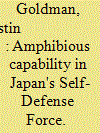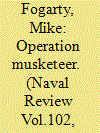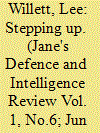| Srl | Item |
| 1 |
ID:
133377


|
|
|
|
|
| Publication |
2014.
|
| Summary/Abstract |
Today the Japanese face an increasingly complex regional-security environment, particularly along the southwestern islands, where incursions by Chinese government vessels are increasingly occurring in what Japan claims as its territorial waters. The security of offshore islands has developed as an area of focus within Japanese defense planning, and Japan has begun building up modest island-defense capabilities.1 Although the nature and range of threats faced have evolved, a core focus of the Japan Self-Defense Force (JSDF ) remains the same- the requirement to protect the nation from an amphibious invasion.2 While the JSDF has developed some robust platforms, its current state also reflects the constraints placed on its development under the 1947 constitution, enacted during the occupation following World War II. …
|
|
|
|
|
|
|
|
|
|
|
|
|
|
|
|
| 2 |
ID:
121670


|
|
|
|
|
| Publication |
2012.
|
| Summary/Abstract |
The following is the text of an address given by the Chief of Army, Lieutenant General
David Morrison, to the Royal Australian Navy's Sea Power Conference in Sydney on 31
January 2012. Lieutenant General Morrison stated that the introduction into the Australian
Defence Force of new amphibious capability is anything but routine. The Landing Helicopter
Docks cannot be thought of as merely a transport capability. Rather they are an integral part
of a combat system with unique, and unprecedented, command and control and sustainment challenges. The acquisition of the Landing Helicopter Docks represents not only far
greater technical complexity in the operating systems than the Australian Defence Force has
previously experienced, but will introduce a far greater complexity into the joint training,
scheduling and integration across and between services. All parts of Defence activity are
going to be affected and will need to adjust. The Army is up for this challenge. The future
generations of Army officers will be trained and exposed to amphibious operations from the
outset of their careers, as a central pillar to how we fight. This will require an agile and joint
mindset that we cannot claim to possess across the entire force at present.
|
|
|
|
|
|
|
|
|
|
|
|
|
|
|
|
| 3 |
ID:
133871


|
|
|
|
|
| Publication |
2014.
|
| Summary/Abstract |
What was the significance of this operation? A case study of lessons learned in an amphibious warfare campaign through a study of its historical - strategic legacy, and of the impact on the RN's amphibious capability.
|
|
|
|
|
|
|
|
|
|
|
|
|
|
|
|
| 4 |
ID:
187695


|
|
|